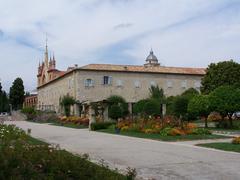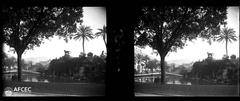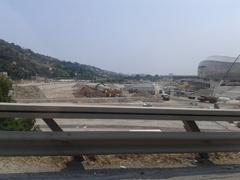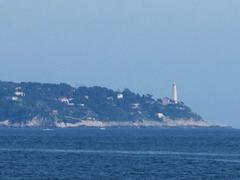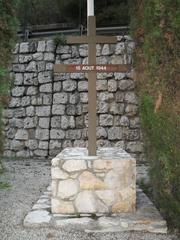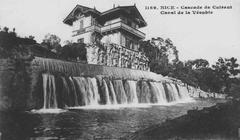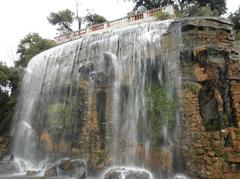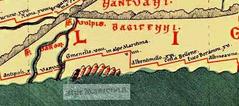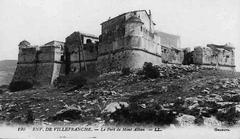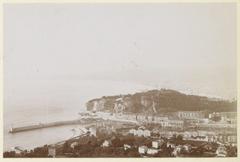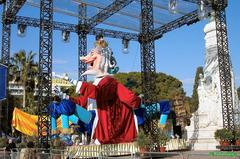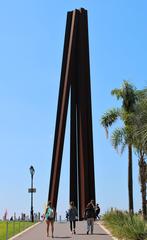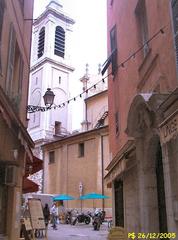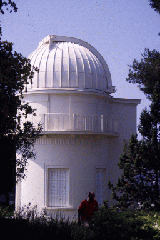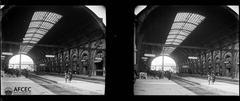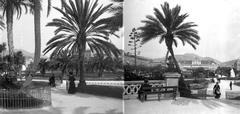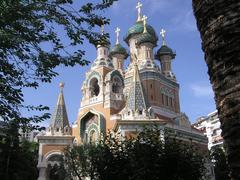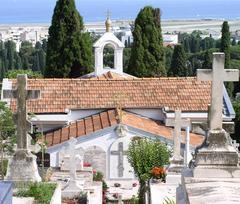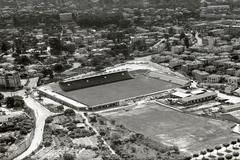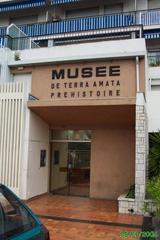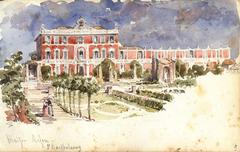
Comprehensive Guide to Visiting Monastère de Cimiez, Nice, France
Date: 23/07/2024
Introduction
The Monastère de Cimiez, nestled in the picturesque Cimiez district of Nice, France, is a site of profound historical and cultural significance. Founded in the 9th century by Benedictine monks from the Abbey of Saint-Pons, this monastery has evolved through the ages, witnessing and adapting to various historical events and transformations. Its rich history is marked by significant milestones, including its transition to a Franciscan monastery in the 16th century, its secularization during the French Revolution, and its eventual restoration and preservation in the 19th century. Today, the Monastère de Cimiez stands as a testament to the region’s religious and cultural heritage, attracting visitors from around the world. This comprehensive guide aims to provide you with all the essential information you need for a memorable visit, including insights into its history, visitor information, travel tips, nearby attractions, and more. Whether you are a history enthusiast, an art lover, or simply seeking a serene escape, the Monastère de Cimiez offers a unique experience that blends historical intrigue with cultural richness. (Nice Tourism, Monastère de Cimiez Official Website, Matisse Museum).
Table of Contents
- Introduction
- History of Monastère de Cimiez
- Visitor Information
- Travel Tips
- Nearby Attractions
- Special Events and Tours
- Photographic Spots
- Accessibility
- FAQ
- Conclusion
- Sources
History of Monastère de Cimiez
Early Beginnings and Foundation
The Monastère de Cimiez, located in the Cimiez district of Nice, France, has a rich history that dates back to the 9th century. Originally, the site was home to a Benedictine monastery established by the monks of the Abbey of Saint-Pons. This early foundation laid the groundwork for what would become a significant religious and cultural landmark in the region.
Transition to the Franciscans
In the 16th century, the Benedictine monks left the monastery, and it was taken over by the Franciscans in 1546. This transition marked a new era for the Monastère de Cimiez, as the Franciscans brought with them a different set of traditions and practices. The Franciscans were known for their commitment to poverty, simplicity, and service to the community, which influenced the development and activities of the monastery.
Architectural Evolution
The architectural evolution of the Monastère de Cimiez is a testament to its long and varied history. The original structure underwent significant changes and expansions over the centuries. The current building, primarily constructed in the 17th century, showcases a blend of Gothic and Baroque architectural styles. Notable features include the cloister, the church, and the monastery gardens, which have been meticulously maintained and restored over the years.
Role During the French Revolution
The French Revolution had a profound impact on the Monastère de Cimiez. In 1791, the monastery was secularized, and the monks were expelled. The property was confiscated by the state and sold to private individuals. During this tumultuous period, many of the monastery’s valuable artifacts and religious items were lost or destroyed. However, the building itself survived and was later repurposed for various uses, including a military hospital.
Restoration and Preservation
In the 19th century, efforts were made to restore and preserve the Monastère de Cimiez. The monastery was returned to the Franciscans in 1864, and significant restoration work was undertaken to repair the damage caused during the Revolution and subsequent years of neglect. These efforts were crucial in preserving the historical and architectural integrity of the site.
Cultural and Religious Significance
The Monastère de Cimiez holds significant cultural and religious importance. It has been a center for religious activities, education, and community service for centuries. The monastery’s church, dedicated to Our Lady of the Assumption, is a place of worship and pilgrimage. The site also houses a museum that showcases the history of the Franciscans and the monastery, including religious artifacts, artworks, and historical documents.
Connection to Henri Matisse
One of the most notable aspects of the Monastère de Cimiez’s history is its connection to the famous artist Henri Matisse. Matisse spent the last years of his life in Nice and was buried in the cemetery of the Monastère de Cimiez in 1954. This connection has added to the cultural significance of the site, attracting art enthusiasts and tourists from around the world.
Visitor Information
Opening Hours
The Monastère de Cimiez is open to visitors from Tuesday to Sunday. The typical visiting hours are from 10 AM to 6 PM. However, these hours may vary on holidays and special occasions, so it is advisable to check the official website for the most current information.
Ticket Prices
Admission to the Monastère de Cimiez is generally free. However, there may be fees for special exhibitions or guided tours. It’s best to consult the official website or contact the visitor center for detailed information on any additional costs.
Best Times to Visit
The best times to visit the Monastère de Cimiez are during the spring and fall when the weather is pleasant and the gardens are in full bloom. Early mornings or late afternoons are ideal for avoiding crowds and enjoying a serene experience.
Travel Tips
How to Get There
The Monastère de Cimiez is easily accessible by public transportation. You can take bus lines 5, 33, and 70 from the city center of Nice. For those driving, there is limited parking available nearby. It’s also a lovely walk from the city center if you prefer to explore on foot.
What to Bring
When visiting the Monastère de Cimiez, it’s recommended to bring comfortable walking shoes, a hat, sunscreen, and a camera to capture the stunning views. A bottle of water is also handy, especially during the warmer months.
Nearby Attractions
Other Historical Sites in Nice
Nice boasts numerous historical sites worth exploring. Some nearby attractions include the Roman ruins at the Cimiez Arenas, the Matisse Museum, and the Marc Chagall National Museum. Each site offers a unique glimpse into the rich cultural heritage of the region.
Dining Options Near Monastère de Cimiez
There are several charming cafes and restaurants near the Monastère de Cimiez where you can enjoy delicious French cuisine. Whether you’re looking for a quick snack or a leisurely meal, the local eateries provide a variety of options to suit all tastes.
Special Events and Tours
Scheduled Events
The Monastère de Cimiez hosts various cultural and religious events throughout the year. These include concerts, art exhibitions, and religious festivals. Check the official website for a calendar of upcoming events.
Guided Tours
Guided tours are available for those who wish to gain deeper insights into the history and significance of the Monastère de Cimiez. These tours are typically led by knowledgeable guides and can be booked in advance.
Photographic Spots
Best Places to Take Photos
The Monastère de Cimiez offers numerous picturesque spots for photography. The monastery gardens, with their lush greenery and floral displays, provide a beautiful backdrop. The cloister and the church interiors also offer stunning architectural details worth capturing.
Accessibility
Information on Accessibility for Disabled Visitors
The Monastère de Cimiez is committed to providing access for all visitors. The site is equipped with ramps and accessible pathways to ensure that those with mobility challenges can navigate the grounds comfortably. It’s recommended to contact the visitor center in advance for specific accessibility needs.
FAQ
What are the Monastère de Cimiez opening hours?
The Monastère de Cimiez is open from Tuesday to Sunday, typically from 10 AM to 6 PM. Check the official website for any changes to these hours.
How much are tickets for Monastère de Cimiez?
Admission is generally free, but there may be fees for special exhibitions or guided tours. Verify with the official website for the latest information.
Are guided tours available?
Yes, guided tours can be booked in advance and are highly recommended for those interested in detailed historical insights.
Conclusion
The Monastère de Cimiez is more than just a historical site; it is a living monument that encapsulates the rich tapestry of Nice’s religious and cultural history. From its early beginnings as a Benedictine monastery to its transformation under the Franciscans, and its resilience through the French Revolution, the Monastère de Cimiez has continually evolved while preserving its architectural and cultural essence. Today, it serves as a center for religious activities, cultural events, and community gatherings, offering visitors a unique opportunity to immerse themselves in a serene and historically rich environment. Whether you are exploring its meticulously maintained gardens, marveling at the blend of Gothic and Baroque architecture, or paying homage to the renowned artist Henri Matisse who rests in its cemetery, the Monastère de Cimiez promises a memorable and enriching experience. Plan your visit today and discover the timeless charm and significance of this remarkable site. For more detailed information, you can visit the Nice tourism website or the Monastère de Cimiez Official Website.
References
- ‘Monastère de Cimiez.’ Nice Tourism. Retrieved from Nice Tourism
- ‘History of the Monastère de Cimiez.’ Monastère de Cimiez Official Website. Retrieved from Monastère de Cimiez
- ‘Henri Matisse and the Monastère de Cimiez.’ Matisse Museum. Retrieved from Matisse Museum
- ‘Franciscan Museum.’ Nice.fr. Retrieved from Franciscan Museum
- ‘Fête de Mai.’ Nice.fr. Retrieved from Fête de Mai
- ‘Matisse Museum.’ Matisse Museum Official Website. Retrieved from Matisse Museum
- ‘Roman ruins.’ Nice.fr. Retrieved from Roman ruins
